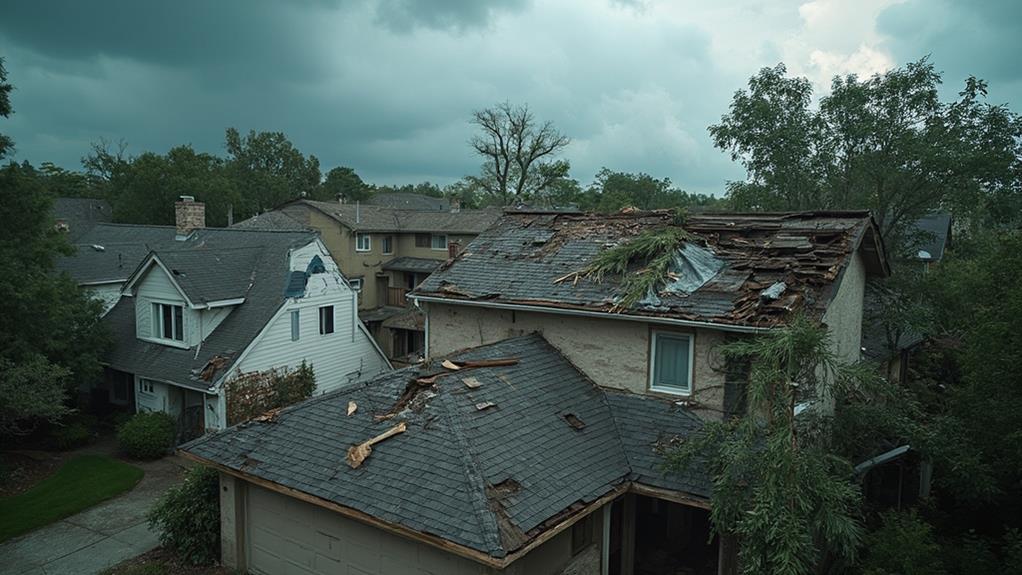Insurance coverage for storm-damaged roofs typically includes wind, hail, and lightning damage. Common exclusions are poor maintenance, normal wear, and floods. To file a claim, promptly report damage, provide thorough documentation, and work with a claims adjuster. Hiring a public adjuster can help navigate complex claims. Negotiating with insurers requires detailed policy knowledge and damage evidence. Consider repair vs. replacement options based on damage extent and policy terms. Regular inspections and maintenance can prevent future damage. Understanding policy deductibles is crucial, as they may vary by storm type or location. Exploring these aspects in depth can lead to better protection and claim outcomes.
Types of Storm Damage Covered
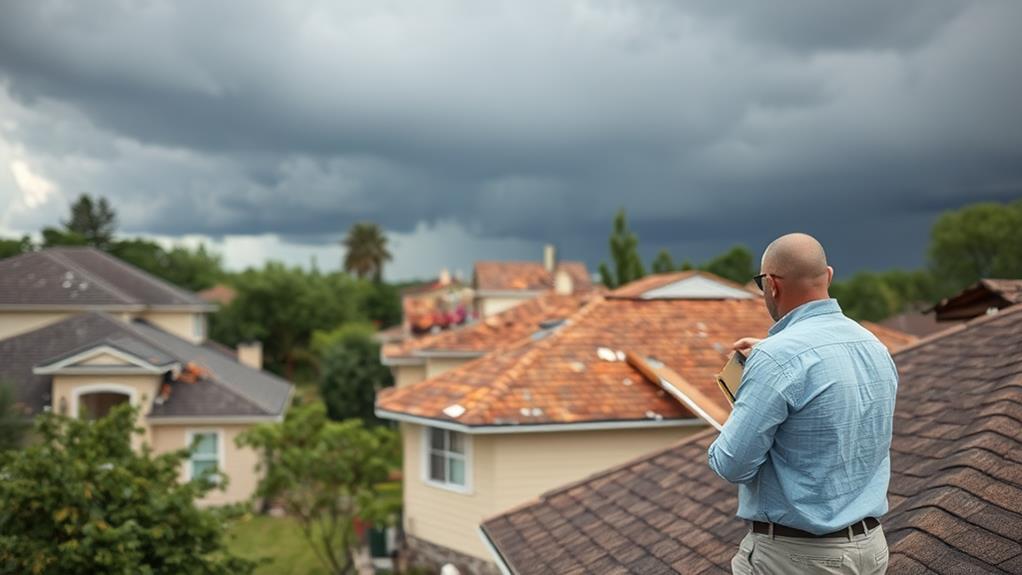
When examining storm-damaged roof insurance, it's crucial to understand the various types of storm damage typically covered by policies. Most standard homeowners insurance policies cover sudden and accidental damage caused by specific weather events.
These generally include:
- Wind damage: This encompasses torn or missing shingles, lifted edges, and damage from flying debris.
- Hail damage: Dents, cracks, or punctures in shingles, as well as granule loss, are common hail-related issues.
- Lightning strikes: Direct hits can cause fires or electrical damage to roofing systems.
- Fallen trees or large branches: Damage resulting from the impact of trees or heavy limbs is usually covered.
- Ice dams: Some policies cover damage caused by ice buildup along roof edges.
- Hurricane and tornado damage: These extreme weather events often lead to extensive roof damage.
It's important to note that coverage may vary depending on your specific policy and location. Some regions prone to certain weather events may have exclusions or require additional coverage. Regular wear and tear, neglect, or pre-existing damage are typically not covered. Always review your policy carefully and consult with your insurance provider to fully understand your coverage for storm-related roof damage.
Common Policy Exclusions
While storm-damaged roof insurance provides crucial protection, policies typically include several common exclusions that homeowners should be aware of. These exclusions often limit coverage or entirely exclude certain types of damage, potentially leaving homeowners responsible for repair costs.
One common exclusion is damage resulting from poor maintenance or pre-existing issues. Insurers expect homeowners to maintain their roofs adequately, and may deny claims for damage exacerbated by neglect. Additionally, normal wear and tear is typically not covered, as it's considered part of routine homeownership expenses.
Many policies exclude damage caused by floods or earthquakes, requiring separate coverage for these specific perils. Cosmetic damage, such as minor dents or discoloration that doesn't affect the roof's functionality, is often excluded as well.
Some policies have limitations on coverage for older roofs or may exclude certain roofing materials altogether. It's crucial for homeowners to review their policies carefully and understand any age-related restrictions or material-specific exclusions.
Lastly, intentional damage or damage resulting from war, nuclear hazards, or government actions are standard exclusions in most homeowners' insurance policies, including those covering storm-damaged roofs.
Documenting Roof Damage
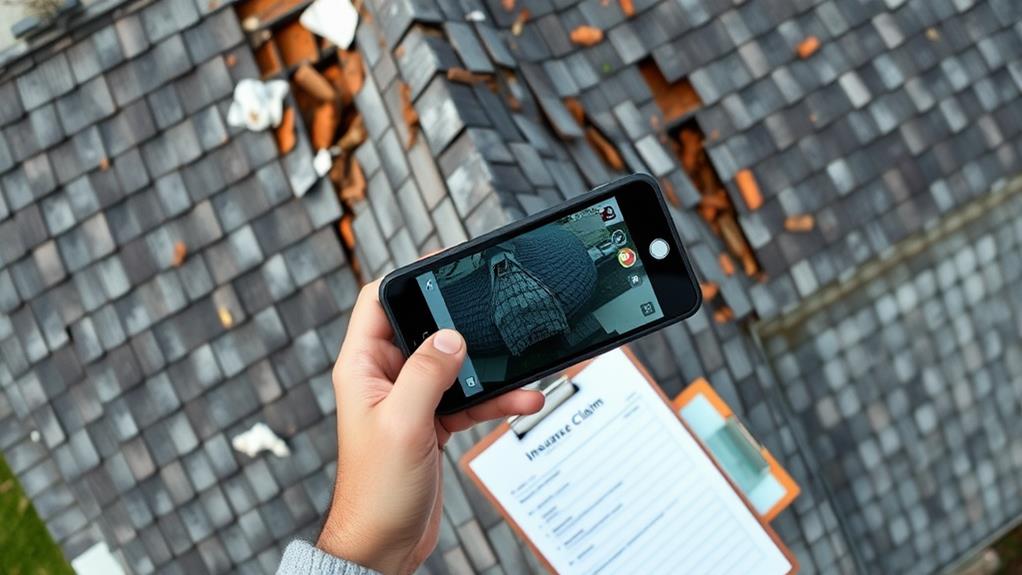
Thoroughness in documenting roof damage is crucial for a successful insurance claim. Begin by taking extensive photographs and videos of the damaged areas, including close-ups and wide-angle shots. Capture images from multiple angles to provide a comprehensive view of the extent of the damage. Document any fallen debris, broken shingles, or visible water stains on ceilings and walls.
Create a detailed written report describing the damage, including the date and time of the storm event. Note specific areas of concern, such as missing shingles, dented gutters, or damaged flashing. Measure and record the size of damaged areas when possible. Keep all receipts for temporary repairs or emergency services related to the roof damage.
Contact a professional roofing contractor to conduct a thorough inspection and provide a written assessment of the damage. This expert opinion can serve as valuable supporting evidence for your claim. Additionally, obtain multiple repair estimates to demonstrate the cost of necessary repairs. Maintain a log of all communications with your insurance company, including dates, times, and summaries of conversations. This documentation will help support your claim and ensure a smoother claims process.
Filing an Insurance Claim
After meticulously documenting the storm damage to your roof, the next step is to initiate the insurance claim process. Contact your insurance provider promptly to report the damage and begin the claim. Most insurers have specific time limits for filing claims, so acting quickly is crucial.
Provide your insurance company with all the documentation you've gathered, including photos, videos, and written descriptions of the damage. Be prepared to share information about your roof's age, maintenance history, and any previous repairs. Your insurer will assign a claims adjuster to assess the damage and determine coverage.
During the adjuster's visit, walk them through the damage and present your documentation. Ask questions about the claim process, timeline, and potential coverage limitations. After the assessment, you'll receive a damage estimate and coverage determination. Review this carefully, and don't hesitate to seek clarification or challenge the assessment if you disagree.
If your claim is approved, discuss the repair or replacement options with your insurer. Some policies offer additional coverage for upgrades to meet current building codes. Be sure to understand your policy's deductible and any coverage limits before proceeding with repairs.
Hiring a Public Adjuster
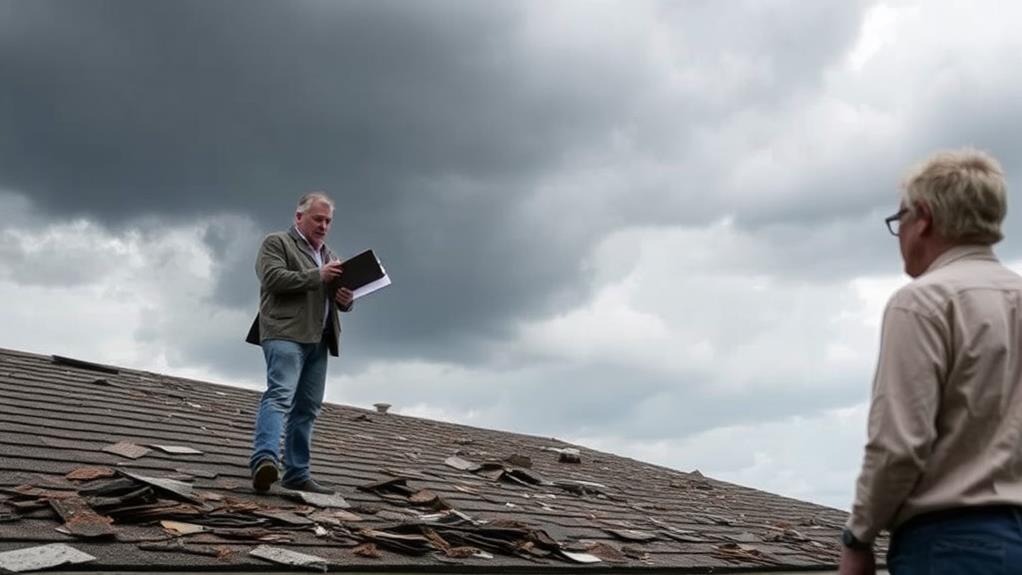
In some cases, homeowners may find the insurance claim process overwhelming or feel that their insurer's assessment is unfair. In these situations, hiring a public adjuster can be beneficial. Public adjusters are licensed professionals who work on behalf of policyholders to negotiate with insurance companies and ensure fair claim settlements.
Public adjusters possess in-depth knowledge of insurance policies, claim procedures, and construction costs. They can accurately assess damage, document losses, and prepare detailed estimates. This expertise often results in higher settlements compared to what homeowners might receive on their own. However, it's important to note that public adjusters typically charge a percentage of the final settlement, usually between 5% and 15%.
Before hiring a public adjuster, homeowners should research their credentials, ask for references, and verify their license with the state insurance department. It's also crucial to understand the terms of the contract, including fees and cancellation policies. While public adjusters can be valuable allies in complex claims, homeowners should first attempt to work directly with their insurance company and consider hiring an adjuster only if they encounter significant difficulties or disputes.
Negotiating With Insurance Companies
Negotiating with insurance companies can be a challenging process for homeowners dealing with storm-damaged roofs. To navigate this process effectively, start by thoroughly reviewing your policy to understand your coverage and rights. Document all damage meticulously, including photos and videos, before any repairs are made.
When communicating with your insurer, be prepared with a detailed account of the damage and estimated repair costs. Request a written explanation for any denied claims or low settlement offers. If you disagree with the adjuster's assessment, consider obtaining independent estimates from reputable contractors to support your case.
Be persistent but professional in your negotiations. Keep detailed records of all communications with your insurance company, including dates, times, and the names of representatives you speak with. If negotiations stall, don't hesitate to escalate the issue to a supervisor or file a complaint with your state's insurance department.
Remember that you have the right to appeal decisions and can even seek legal counsel if necessary. While the process may be time-consuming, staying informed and assertive can significantly improve your chances of receiving fair compensation for your storm-damaged roof.
Roof Repair vs. Replacement
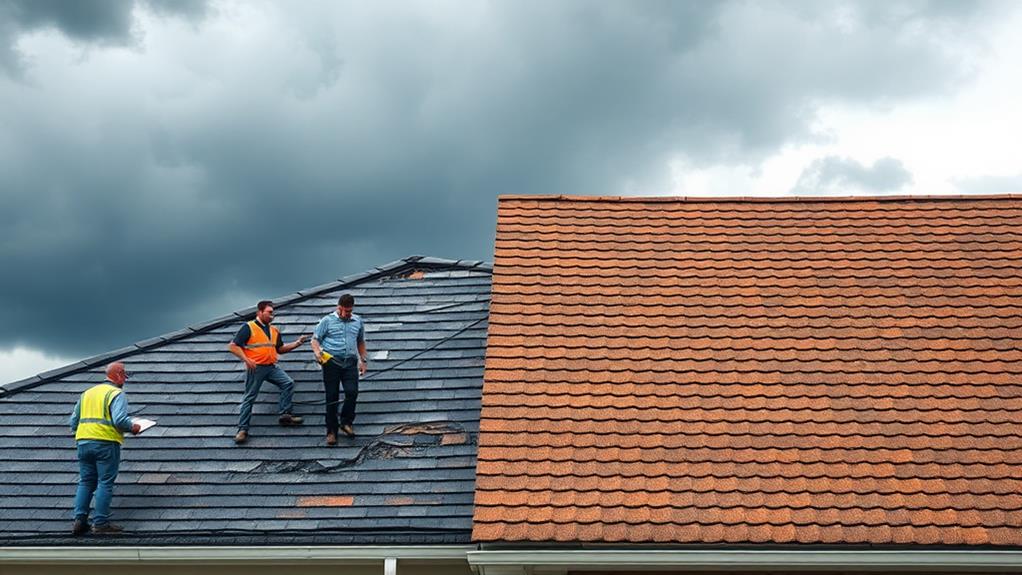
A critical decision homeowners face when dealing with storm-damaged roofs is whether to repair or replace the entire structure. This choice significantly impacts insurance claims and long-term home protection.
Repairs are typically less expensive and faster, making them suitable for minor damage like a few missing shingles or small leaks. However, they may not address underlying issues or match the existing roof perfectly.
Roof replacement, while more costly and time-consuming, offers comprehensive protection and can increase property value. It's often necessary for extensive damage, multiple leaks, or older roofs nearing the end of their lifespan. Insurance companies generally prefer repairs for cost-effectiveness but may approve replacements if damage exceeds a certain threshold or if repairs would be inadequate.
Factors influencing the decision include the roof's age, extent of damage, local building codes, and insurance policy terms. Homeowners should consult with professional roofing contractors and insurance adjusters to assess the damage thoroughly. They should also consider long-term costs, energy efficiency, and potential future issues when deciding between repair and replacement. Ultimately, the goal is to ensure the roof's integrity and maximize the insurance claim's value.
Preventing Future Storm Damage
While addressing current roof damage is vital, proactive measures can significantly reduce the risk of future storm-related issues. Regular roof inspections, especially after severe weather events, can help identify potential vulnerabilities before they escalate. Ensure gutters and downspouts are clear of debris to prevent water buildup and ice dams.
Trim overhanging tree branches that could fall onto the roof during high winds or heavy snow.
Consider upgrading to impact-resistant roofing materials, such as Class 4 shingles or metal roofing, which offer superior protection against hail and wind damage. Proper attic insulation and ventilation can help regulate temperature and moisture levels, preventing ice dams and extending the roof's lifespan. Install roof straps or hurricane clips to reinforce the connection between the roof and walls, enhancing structural integrity during high winds.
For areas prone to specific weather events, additional measures may be necessary. In hurricane-prone regions, consider installing a secondary water barrier beneath the roof covering. In areas with heavy snowfall, snow guards can prevent sudden snow slides. By implementing these preventative strategies, homeowners can minimize the likelihood of severe storm damage and potentially reduce insurance premiums.
Understanding Policy Deductibles
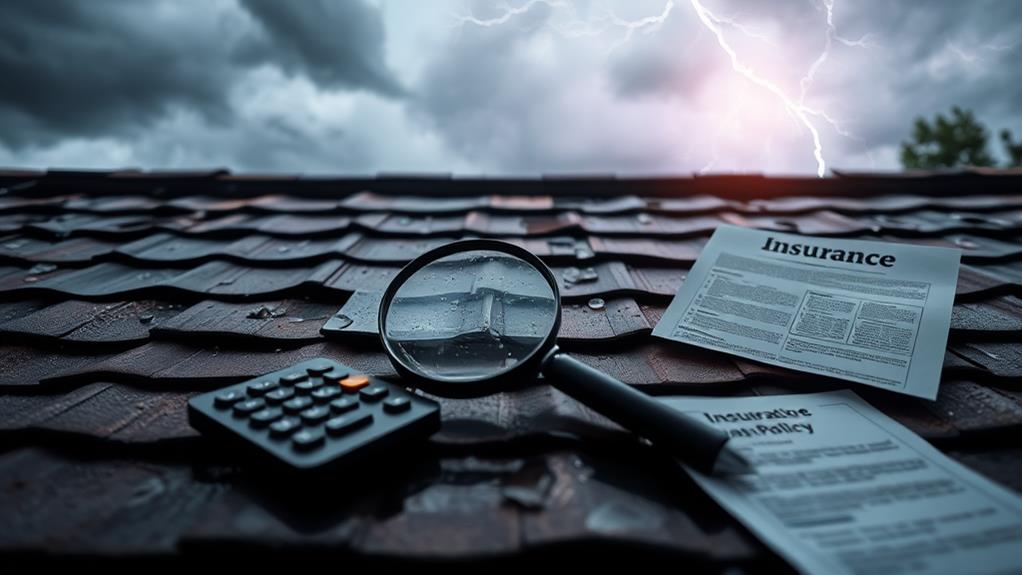
When filing a storm-damaged roof insurance claim, understanding your policy's deductible is crucial. A deductible is the amount you must pay out-of-pocket before your insurance coverage kicks in.
For storm damage, policies often have two types of deductibles: a standard deductible and a percentage-based deductible for specific perils like hurricanes or windstorms.
Standard deductibles are typically a fixed amount, such as $500 or $1,000. Percentage-based deductibles are calculated as a percentage of your home's insured value, usually ranging from 1% to 5%. For example, if your home is insured for $300,000 with a 2% hurricane deductible, you'd be responsible for $6,000 before insurance covers the remaining damage.
It's important to review your policy carefully to understand which deductible applies to storm damage. Some policies may have separate deductibles for different types of storms or may vary by geographic location. Additionally, some states have laws regulating how insurance companies can apply storm deductibles. Always consult with your insurance agent to clarify any questions about your policy's deductibles and how they might affect your storm-damaged roof claim.
Frequently Asked Questions
How Long Do I Have to File a Claim After Storm Damage?
The timeframe for filing a storm damage claim varies by insurance provider and policy. Generally, it's advisable to file as soon as possible, typically within 30 to 60 days. However, some policies may allow up to one year.
Will My Insurance Rates Increase if I File a Roof Damage Claim?
In a world of sky-high premiums, filing a roof damage claim may impact your insurance rates. While not guaranteed, some insurers might increase premiums after a claim. Consider the claim's value against potential rate increases before filing.
Can I Choose My Own Roofing Contractor for Repairs or Replacement?
In most cases, you can choose your own roofing contractor for repairs or replacement. However, it's advisable to consult your insurance policy and communicate with your insurer to ensure the selected contractor meets their requirements and guidelines.
What if My Insurance Company Denies My Roof Damage Claim?
You anxiously await the insurance company's response, hoping for the best. If your claim is denied, don't despair. You can appeal the decision, provide additional evidence, or seek a second opinion from an independent adjuster or roofing expert.
Are Temporary Repairs Covered While Waiting for Permanent Roof Restoration?
Temporary repairs are typically covered by insurance policies while awaiting permanent restoration. Insurers often encourage policyholders to mitigate further damage through immediate, reasonable repairs. However, it's crucial to document all temporary work and retain receipts for reimbursement.
Conclusion
Understanding insurance coverage for storm-damaged roofs is crucial for homeowners to navigate the claims process effectively. Proper documentation, awareness of policy details, and professional assistance can significantly impact claim outcomes. Interestingly, the Insurance Information Institute reports that wind and hail damage accounted for 34.2% of homeowners insurance losses in 2019, underscoring the prevalence of storm-related roof damage. By implementing preventive measures and maintaining adequate coverage, property owners can mitigate financial risks associated with severe weather events.
